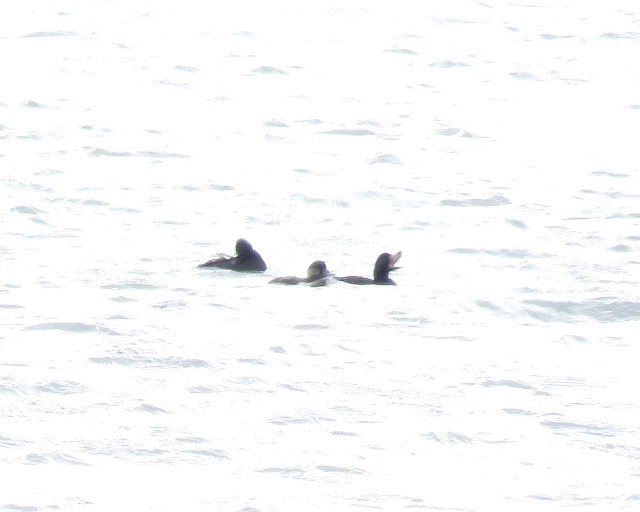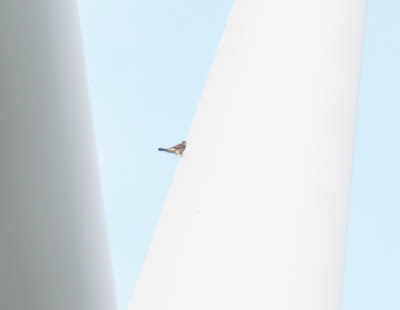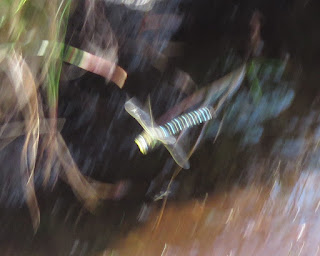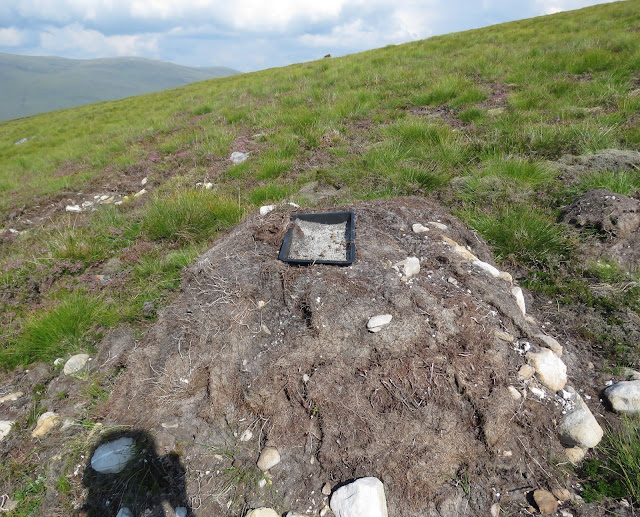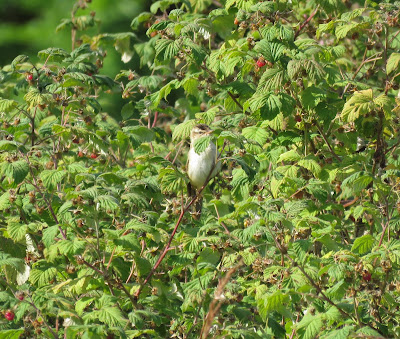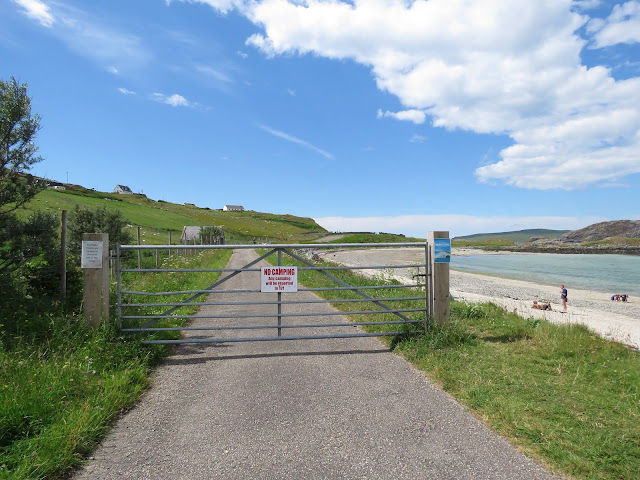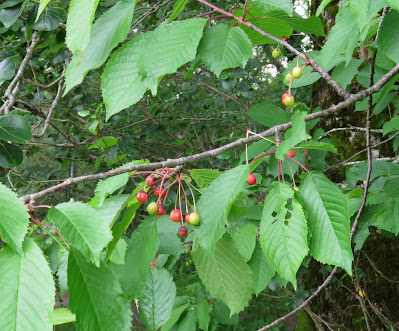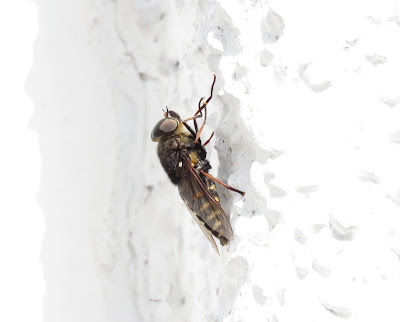Saturday, July 31, 2021
A walk at Achnahaird that was cut short thanks to spatters of rain and a very strong wind off the sea brought a flock of wary oystercatchers - migrants, presumably - and my first two returning sanderling.
Back at the car park, we walked a short way in the other direction to check if the colony of colletes bees was again present; it was, and very active, with bees going in and out of their nests or forming a "mating ball" in which several males try to mate with a female.


I'm fairly sure these are Colletes succinctus - also known as heather colletes bee or common colletes bee. This raises the problem I have with initial capitals for common names; if there is a well-known common name in English for a particular insect - e.g. southern hawker - then it makes sense to give it initial caps. But when there's a variety of common names to choose from then the use of initial caps doesn't make sense - it just makes for confusion. Also, the same common name can be duplicated: there are, for instance, two kinds of hoverfly that seem to be known as "bog hoverfly" - yet they are clearly two separate species. Some species have no common name at all so you have to use the scientific one; and I would think entomologists probably do this all the time. The odd thing is, while I can often remember the Latin names for insects and plants, I can recall very few Latin names for birds.
Across the headland at Badentarbat I was about to tuck into a sandwich when a group of three dark dots quite far out looked different from the Eider ducks that were swimming about near the jetty. It was a good job I got out of the car to check, because they were common scoter. They appeared to be two drakes and a duck; there was some evidence of courting behaviour, with one of the males snapped with open bill as though calling; unfortunately they were too far out to hear anything.
Bonxies were active on this side of the headland, and a few gannets were seen. At Achnahaird while we were watching the bees, a family party of twite flew over calling and Greger pointed out a couple of porpoises making their way along the edge of the bay just below us, and heading all the time back out to sea.
Tuesday, July 27, 2021
Beinn Liath Mhor a' Ghiubhais Li - for the sixth time!
Yesterday: We used two cars again and followed the route we took in April, along the ridge from the wind farm to the Corbett - its name meaning "big grey hill of the coloured pine" (walkhighlands.co.uk). A mountain hare was seen at the edge of the moorland. A small raptor had me flummoxed - merlin or kestrel? I think the fanned tail is pretty long, and when the bird landed momentarily on the blade of a wind turbine, it seemed to show the colouration of a male kestrel - although the fine barring on the tail suggests a female.
Instead of traversing the flank of a named top (Beinn Liath Bheag) as we did last time, joining the ridge further along, we went straight upwards to gain the summit. Glad we did as it's a nice top. I clicked off two shots, one looking back at the wind-farm and one looking ahead as Greger set off again.
A persistent faint piping call betrayed the presence of golden plover, and an adult bird flew up from the heather and landed for a while on a lookout point to see us off its territory.
A large herd of red deer seen at a distance seemed to be mostly hinds with well-grown calves, although a few stags were also present. Much closer were two juvenile wheatears.
There were quite a few meadow pipits around - but this bird, one of two on the top where we had lunch, looks in some ways rather like a tree pipit. Dunno. (Later: I think it's a young meadow pipit.)
We reached the final, highest top of the ridge and made our way slowly down; and just when I'd given up hope of seeing ptarmigan, I glanced over to the right and spotted one against a jumble of pale rocks.

I'm ashamed to say I wasn't thinking about any young she might have, and when Greger pointed out that there were chicks present I thought he'd made a mistake - surely those birds taking to the air couldn't be ptarmigan chicks? But they were. (The BWP states that ptarmigan chicks are "capable of precocious flight at 10-15 days". Amazing.) Just one showed the relaxed attitude characteristic of its species to intruders by simply walking away - and then turning to have a good look at us before continuing down the hillside until just the top of its head could be seen. Anyway, the little family didn't go far, and there were no eagles in the sky.
The views were a bit misty today. The brown patch on the right-hand side of this photo is the dried-out end of Loch Glascarnoch.
It was a wrench to leave these lovely high places, especially as we knew that a tedious, steep, wet stretch awaited us before we reached the forest track; but we had to get back down to that road at some point so off we went again.
Among the peat hags - which were unusually dry - a small shrunken pool was brought to life by questing dragonflies - three common hawkers and a four-spotted chaser. My efforts at capturing them weren't very successful, but I can always pretend that with this image I was deliberately aiming for a stylised depiction of a common hawker; after all, it shows the main features of a brown-blue-yellow abdomen and a yellow leading edge to the wings.
Further down still, I was surprised to see a grit tray on top of what seemed to be a purpose-made mound of earth and rocks.
Grit trays are found on grouse moors - and I think the grit is often medicated. There are red and black grouse hereabouts, though we didn't see any today. Droppings in the tray show that it's being used, but which grouse species the droppings belong to, I've no idea - and in any case, the more numerous round droppings are those of hare.
I recalled the corvid trap that I'd seen on a recce of this route a year or so ago, and wondered if the estate was intensifying its grouse-shooting activities - although they surely can't be of the "driven" variety. I'd always thought that walked-up grouse shooting was a bit more "natural", although I'd rather they didn't do it at all. My heart sank - something "farmy" had arrived where once it was wild.
The tedious last stretch of hillside having been negotiated, we set off down the track through Altan Wood. A golden-ringed dragonfly was patrolling here, and further down we encountered an azure hawker - which seemed to be feeding on a crane fly.
The Fannichs car park was busy, so quite a few people were walking today - but we'd seen no-one on our hill. Although the last part of the walk had been done in warm sunshine, back at Ullapool we found the low cloud of the previous day hadn't lifted; and we might have found this depressing if we hadn't been so absolutely knackered.
A postscript: When I sat writing this walk up this morning, I felt something on the back of my neck and pulled it away from my hair thinking it was a tick. I found this - a deer ked - which has shed its wings, so must have thought it had reached its host. How did it survive two hot showers - one last night and one this morning?!
A reminder that not all close encounters with wildlife are agreeable.
Saturday, July 24, 2021
We parked at the walkers' car park by the cattle grid on this warm sunny day and took the path that contours Ullapool Hill, through scattered conifers and gorse bushes. Several Golden-ringed Dragonflies were hawking over the bracken, and a goldcrest was heard but not seen. As we gained height a bunch of swallows flew over twittering and then a house martin swooped by.
We had stopped for a breather and were gazing north when I spotted an all-dark bird flying fast above the Ullapool river gorge towards the village. "It's a SWIFT!" I called out, and despite my garbled directions Greger immediately got onto it. It was then seen very distantly against the sky, and by chance I caught it in a couple of rubbish shots, here with the Summer Isles in the haze below.
We don't often see swifts on the west coast, and this was a lovely way to encounter one. Just as well we did spot it as the walk (out to Loch Achall and back down the quarry road) - though very enjoyable - didn't bring anything else in the way of either birds or dragonflies.
Friday, July 23, 2021
We're having some warm sunny weather at last. On a village walk today I saw a rather tattered Small Copper butterfly in the dog-walking field (actually, I think it's called the Mill Field).
At the other end of the field, a sedge warbler looked as though it had designs on the raspberries.
Nearly two weeks ago, an Azure Hawker was hunting over bog myrtle up the very dusty quarry road....
.....so I had hopes of seeing both this and the Northern Emerald on the same walk. But I've been up there loads of times since then and still not seen one - and now the Azures have disappeared from both this site and the one above the Braes. Yesterday, I counted 25 Dark Green Fritillaries above the lower quarry; but if I do the Big Butterfly Count this year, I think I'll do it in the garden as the buddleia is just coming out.
This Common Darter corresponds to one featured on british-dragonflies.org.uk and labelled "over-mature female"......
.....which is an apt description of how I feel.
Monday, July 19, 2021
We made another visit to Monadh Mor last week and took a different route to view two more pools. At the first we saw mostly Four-spotted Chasers and a blue hawker that stayed out over the water and remained unidentified. At the smaller pool I was thrilled to get a first glimpse of a male White-faced Darter - although it remained distant and then disappeared.
Distinctive markings make this an easy dragonfly to identify, even without seeing the white face. It's now fairly scarce I think, so it would have been nice to see a female as well. A male Black Darter was also present.
Meanwhile, up the quarry road a couple of days ago, I counted at least fifteen Dark Green Fritillaries.
Just above the lower quarry, and nectaring mostly on the flower of Scotland.
Monday, July 12, 2021
We explored Monadh Mor (the Big Moor) on the Black Isle, in hopes of a White-faced Darter, leaving the main track to follow a lovely forest path and eventually coming to two tree-ringed pools, boggy at the edges with sphagnum moss.
There were many damselflies - among them this Emerald.
We were unlucky with the darter, but next time we visit we'll continue along the main track which seems to lead to more pools. Birds weren't very forthcoming; a chiffchaff and a goldcrest were singing, and a red kite cruised over the tree-tops calling. Two yellowhammers were singing unseen near the viewpoint.
Tuesday, July 06, 2021
The road running up to the cemetery at Scourie is still closed off, so if you want to visit the beach or walk out on the headland you have to park in the small area by the hide. We were lucky enough to get a place, and set off on a bright morning of blue seas and sky, with the warmth of the sun tempered by a decidedly cool north wind.
Two great northern divers were the best thing on the sea - one an adult, and the other possibly a juvenile.
A bonxie cruised over the headland, but we saw no Arctic skuas. The common sandpiper was on the other side of the bay at Scourie jetty.
I think I'll have to give in and make a visit to Handa Island if I want to see Arctic skuas. I'd hoped to see one on my trek out to the trig point five days ago, but drew a blank. In 2005 while on holiday, I just caught sight of a creamy bird as it flew over the car park at Achnahaird and realised this was an Arctic; so the following year, we walked the headland, along the road to Reiff and then back across the cliffs. We were further over towards the sea than the trig point, but somewhere in that area we saw three Arctics and I took this picture with Greger's old Nikon E995 (bought mostly for digiscoping, at which I proved spectacularly useless!).
Not exactly a blast - but certainly from the past....
I don't know if they nested here, but it seems they don't now - although we did see two Arctic skuas at Achnahaird in July 2016. Oh well, there's always the ferry.......
Monday, July 05, 2021
A pellucid hoverfly was a nice find on a flowering tree or shrub (no idea which tree - more research needed) on the edge of the football field. Later: It's probably a viburnum, possibly V. tinus.
We'd noticed green wild cherries here on our last walk, and now they were ripening in the sun.
Here's hoping for a hawfinch or two - not that they need the berries to be ripe, although they do sometimes eat the pulp as well (BWP).
At home in the garden, a large dark mark on the wall by the bedroom window turned out to be a horse fly - but the biggest one I've ever seen. There's no space between the eyes, so it's a male.
It's apparently a Dark Giant Horse Fly (I'm inconsistent with initial caps for names, but I think this insect deserves them), and was at least an inch long. Greger looked at it through the window as I snapped it, making suitably terrified faces - I think he was relieved there was glass between the fly and him.
Friday, July 02, 2021
Out in the Coigach area, I had been heading for the beach; but on a whim, I drove past the turning and parked instead in the rough lay-by above Loch a' Chaoruinn. My destination, I'd decided, was the Cnoc an Lochain Deabhaidh trig point, standing where a rocky outcrop breaks the horizon in the centre of the picture. (A cnoc is a hill or hillock, and deabhaidh apparently means 'seepage'.)

I tried to reach this trig point a few years ago from Achnahaird - and failed. I was wearing new leather boots which were hard and a bit too big, and it was pretty wet underfoot. Even on that route, where you can stick to the higher ground, there were still bogs. The wet mud kept sucking my boots off my feet and soon my heels were blistered - so I had to turn back. On this road, the OS map gives a spot height of 74m just below the lay-by; so I was setting off from about 80m above sea level - the same height as the trig point. However, in between is a low-lying marshy area with a few lochs dotted about. I wouldn't normally dream of trying to cross it - but today, after a prolonged dry spell, it shouldn't be too bad (I hoped).
A skua was a good bird to get me on my way as I dropped down the bank before climbing to the first cairn.

I ignored the climb to the second cairn, and edged my way round the flank of the small hillock instead; this put me close to the loch, where I flushed a female mallard. I was surprised to pick up a path, not going directly towards the trig point but skirting the base of the high ground instead, and making the walking pleasant. But eventually I abandoned the path and struck off across the spongy terrain, trying to pick areas where heather was growing rather than bog myrtle. I'm sure it was as dry as it ever gets, but there were still plenty of pale mossy patches that looked innocuous but hid squelchy ground beneath - miniature Grimpen Mires! From car to destination was just under three kilometres - it felt three times that, with the added obstruction of two fences to cross. But at last I reached the trig point, and the first thing I did was send a photo to Greger (although it pinged off to him before I could send a message with it - still not entirely in charge of my new smartphone!) He'd stayed at home while a man came to repair the wooden fascia under the guttering, after a leak in the roof.

I had seen a pair of wheatears, loads of meadow pipits, and a few skylarks on the walk out; while the faint call of a dunlin was nice to hear and not something to investigate further, as it could still be breeding. And that was it for birds - but I did have company at the trig point in the rather grotesque shape of a giant tachinid fly.
I spent some time in this lovely lonely spot, looking across the moorland at the hills of Coigach, and watching the ferry as it tracked across the blue, blue sea towards Stornoway. It was with a sinking heart, however, that I looked back at my car, twinkling in the sun where the road made a sloping line across the grey-green landscape.
Nothing for it but to set off on the return journey - although I would vary it by heading for the high ground. Bye-bye trig point I thought, looking back at it over the Lochan Deabhaidh from which it gets its name. The foreground shows a nice dried-up area, although it was still fairly rough walking.
But further on I was back in the bogs. However, they had their attractions - as in an absolute mass of sundew plants. I'm not sure if they were great or oblong-leaved, or a hybrid between great and common/round-leaved. It was difficult to get the whole plant in focus, so I held one of the flowers between my (very red - must have been the heat) fingers in order to focus and show some detail.
I gave up on my plan to gain the high ground as it meant a diversion and too many ups and downs of rocky knolls. Watching out for a particular patch of bracken that I'd noted when leaving the path, I finally re-found the path and followed it back to the road.
The trig point had no flush bracket, and I learnt from the website trigpointing.uk that it's a "secondary" triangulation pillar - that is, not one of the 383 that constituted the original, "primary" network.





